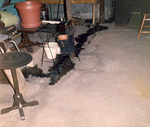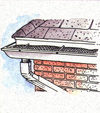For decades, thousands of satisfied homeowners have relied on The B-Dry System to solve their wet basement problems.
For more information, immediate assistance or a free estimate, select one of the options below.

Separate Areas of Damp
or Wet Spots
Wall Cracks and/or Degraded Parging - During the original construction, builders will usually coat the exterior foundation walls with a thin coat of cement called "parging", followed by a waterproof or damp-proof asphalt or rubberized coating. As the home settles and expansion and contraction occurs over seasonal changes, small cracks occur and fracture the waterproof coatings. Water, either under pressure or through absorption, enters the cracked walls and starts breaking down the parging. Eventually, the basement walls start leaking or forming damp spots.
Repairing Cracks in Basement Walls: If the problem areas are not too deep, the soil outside can be dug out by hand to repair the areas. Deeper areas will require machinery.
Before repairing the walls, they must be cleaned properly and allowed to dry. Look for an exterior foundation coating that has elastomeric qualities to span cracks or openings as the foundation contracts and expands during temperature changes.
Backfilled material should not be tamped because that can cause damage to the new coating or possibly damage the walls even more. Backfill the area slightly higher than the original surface elevation to allow for settling of the soil. There are paintable waterproof coatings available for interior application. Read the manufacturer's application directions and product warranties to see which product fits your needs.
Another approach from the inside is to install waterproof rigid sealer panels to direct any wall leakage down below the floor. This approach requires installing a drainage system below the floor and along the walls to be treated. The basement's drainage system will usually empty into a sump pump container that discharges the collected water outside.
Regardless of the approach you decide on, check manufacturer's warranties to see what type of coverage is available.

Clogged Gutters - Blocked rain can cause or substantially contribute to an isolated water problem. When gutters become blocked, roof water spills over the gutters directly against the foundation. Water quickly saturates the soil alongside the basement wall causing water pressure. A large amount of water spilling into a small area will also cause soil erosions and possible foundation settling.
Solutions: First, clean all your rain gutters and ensure that they are working properly. Second, mark your calendar so you remember to clean your gutters in early Spring, mid-Fall and again in the late Fall, after all the leaves have fallen.
Installing gutter screens is a good option, but sometimes they get blocked up.

Extend Your Downspouts - Make sure your downspouts are extended away from your home by at least 10 feet or so. They should empty out into an area that drains away properly and won't allow water to back-up toward the foundation. If your downspouts go underground, make sure they empty out to "daylight" at some point. Run water through them to make sure they are not clogged with leaves.
Surface Water and Low Spots - Look at the yard surface areas directly next to your home. Sometimes this area settles down from loose original backfilled material.
Look at your overall yard contours. Sometimes, this is best done during a substantial rain storm. See have water reacts and flows. Look for water headed toward your home or ponding near it.
Solutions - Add soil to low areas and create a gentle slope "away" from your foundation.
If you have large areas that are directing surface water toward your home, you will probably need a professional landscaper with equipment to correct your problems. Sometimes, a landscaper can create a swale or lower contoured area to direct surface water to run around and away from your home.
Plant Boxes or Retainer Walls - If your wet spots inside correlate to the same areas in which you have planter boxes or retainer walls on the outside, it is likely that they are holding water and causing the problem.
Solution - Your solution to this problem may be as simple as drilling drain holes near the bottom of your planters or outside retaining wall. Drain holes will allow the water to slowly drain out so it doesn't build up and create a problem.
If retainer walls are being pushed out by frost, your solution might be to re-build the walls with drain tile and put crushed stone behind them for drainage.
© 2017 B-Dry Owner's Association
RECOMMEND THIS PAGE